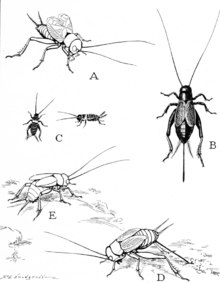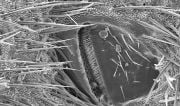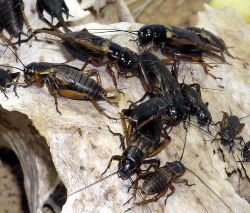Difference between revisions of "Cricket (insect)" - New World Encyclopedia
Rick Swarts (talk | contribs) |
Rick Swarts (talk | contribs) |
||
| Line 19: | Line 19: | ||
}} | }} | ||
| − | In [[zoology]], '''cricket''' is the common name for any of the [[insect]]s in the family '''Gryllidae''' of the orthopteran suborder Ensifera (long-horned grasshoppers), characterized by | + | In [[zoology]], '''cricket''' is the common name for any of the [[grasshopper]]-like [[insect]]s in the family '''Gryllidae''' of the [[Orthoptera|orthopteran]] suborder Ensifera (long-horned grasshoppers), characterized by long [[antenna (biology)|antennae]], strong hind legs [[adaptation|adapted]] for jumping, and in many species males that make chirping sounds. |
| − | + | In addition to the family Gryllidae ("true crickets"), there are several other insects in the order [[Orthoptera]] and suborder Ensifera that have the name cricket as part of their common name, including mole crickets (family Gryllotalpidae), ant crickets (family Myrmecophilidae), camel crickets and cave crickets (family Rhaphidophoridae), dune crickets (Schizodactylidae), king crickets (family Anostostomatidae), leaf-rolling crickets (family Gryllacrididae), and Jerusalem crickets (family Stenopelmatidae). The closely related family [[Tettigoniidae]], whose members are commonly known in American English as katydids, are called bush crickets in British English. | |
| − | ( | ||
==Overview== | ==Overview== | ||
| Line 31: | Line 30: | ||
The suborder is divided into six superfamilies, 21 families, 1,900 genera, and 11,000 described species (Grzimek et al. 2004). The largest superfamily is Tettigonioidea (katydids or bush-crickets) with over 1,000 genera and 7,000 known species (Grzimek et al. 2004). The superfamily Grylloidea (crickets) includes over 500 genera and 3,500 described species. | The suborder is divided into six superfamilies, 21 families, 1,900 genera, and 11,000 described species (Grzimek et al. 2004). The largest superfamily is Tettigonioidea (katydids or bush-crickets) with over 1,000 genera and 7,000 known species (Grzimek et al. 2004). The superfamily Grylloidea (crickets) includes over 500 genera and 3,500 described species. | ||
| − | Members of the family Tettigoniidae are commonly known as bush crickets or katydids, and are closely related to the [[cricket]]s. | + | Members of the family Tettigoniidae are commonly known as bush crickets or katydids, and are closely related to the [[cricket]]s. |
| + | |||
| + | There are about 900 [[species]] of crickets. They tend to be [[nocturnal]] and are often confused with [[grasshopper]]s because they have a similar body structure including jumping hind legs. | ||
Grasshoppers develop by [[metamorphosis#Insect metamorphosis|incomplete metamorphosis]], a process in which the larvae resembles the adults somewhat, as they have compound [[eye]]s, developed legs, and wing stubs visible on the outside, but the juvenile forms are smaller, lack fully developed reproductive organs, and, if the adult has wings, lack wings. In this mode of development, which involves gradual change, there are three distinct stages: The egg, nymph, and the adult stage, or imago. There is no pupal stage characteristic of complete [[metamorphosis]]. Through successive [[ecdysis|molts]], the nymphs develop wing buds until their final molt into a mature adult with fully developed wings. | Grasshoppers develop by [[metamorphosis#Insect metamorphosis|incomplete metamorphosis]], a process in which the larvae resembles the adults somewhat, as they have compound [[eye]]s, developed legs, and wing stubs visible on the outside, but the juvenile forms are smaller, lack fully developed reproductive organs, and, if the adult has wings, lack wings. In this mode of development, which involves gradual change, there are three distinct stages: The egg, nymph, and the adult stage, or imago. There is no pupal stage characteristic of complete [[metamorphosis]]. Through successive [[ecdysis|molts]], the nymphs develop wing buds until their final molt into a mature adult with fully developed wings. | ||
Revision as of 16:58, 1 December 2007
| Gryllidae | ||||||||||||||
|---|---|---|---|---|---|---|---|---|---|---|---|---|---|---|
 The common black cricket, Gryllus assimilis
| ||||||||||||||
| Scientific classification | ||||||||||||||
| ||||||||||||||
|
See Taxonomy section |
In zoology, cricket is the common name for any of the grasshopper-like insects in the family Gryllidae of the orthopteran suborder Ensifera (long-horned grasshoppers), characterized by long antennae, strong hind legs adapted for jumping, and in many species males that make chirping sounds.
In addition to the family Gryllidae ("true crickets"), there are several other insects in the order Orthoptera and suborder Ensifera that have the name cricket as part of their common name, including mole crickets (family Gryllotalpidae), ant crickets (family Myrmecophilidae), camel crickets and cave crickets (family Rhaphidophoridae), dune crickets (Schizodactylidae), king crickets (family Anostostomatidae), leaf-rolling crickets (family Gryllacrididae), and Jerusalem crickets (family Stenopelmatidae). The closely related family Tettigoniidae, whose members are commonly known in American English as katydids, are called bush crickets in British English.
Overview
Orthoptera ("straight wings") is a widespread order of generally large- or medium-sized insects with incomplete metamorphosis (hemimetabolism), chewing/biting mouthparts, and two pairs of wings, held overlapping the abdomen at rest. The forewings are narrower than the hind wings and hardened at the base, and the hind wings are membranous and held folded fan-like under the forewings when at rest. This order includes grasshoppers, crickets, katydids, and locusts.
The suborder Ensifera (long-horned grasshoppers) consists of crickets and katydids. Members are characterized by fine and threadlike antennae with well over 30 segments (except fossil representatives), stidulatory specializations of the forewings to make sounds, auditory organs (when present) linked via modified tracheae to the enlarged mesothoracic spiracles, and a six-valved ovipositor.
The suborder is divided into six superfamilies, 21 families, 1,900 genera, and 11,000 described species (Grzimek et al. 2004). The largest superfamily is Tettigonioidea (katydids or bush-crickets) with over 1,000 genera and 7,000 known species (Grzimek et al. 2004). The superfamily Grylloidea (crickets) includes over 500 genera and 3,500 described species.
Members of the family Tettigoniidae are commonly known as bush crickets or katydids, and are closely related to the crickets.
There are about 900 species of crickets. They tend to be nocturnal and are often confused with grasshoppers because they have a similar body structure including jumping hind legs.
Grasshoppers develop by incomplete metamorphosis, a process in which the larvae resembles the adults somewhat, as they have compound eyes, developed legs, and wing stubs visible on the outside, but the juvenile forms are smaller, lack fully developed reproductive organs, and, if the adult has wings, lack wings. In this mode of development, which involves gradual change, there are three distinct stages: The egg, nymph, and the adult stage, or imago. There is no pupal stage characteristic of complete metamorphosis. Through successive molts, the nymphs develop wing buds until their final molt into a mature adult with fully developed wings.
Cricket chirping
Crickets are known for their chirp (which only male crickets can do; male wings have ridges or "teeth" that act like a "comb and file" instrument). The left forewing has a thick rib (a modified vein) which bears 50 to 300 "teeth". The chirp is generated by raising their left forewing to a 45 degree angle and rubbing it against the upper hind edge of the right forewing, which has a thick scraper (Berenbaum 1995). This sound producing action is called "stridulation" and the song is species-specific. There are two types of cricket songs: a calling song and a courting song. The calling song attracts females and repels other males, and is fairly loud. The courting song is used when a female cricket is near, and is a very quiet song.
Crickets chirp at different rates depending on their species and the temperature of their environment. Most species chirp at higher rates the higher the temperature is (approx. 60 chirps a minute at 13°C in one common species; each species has its own rate). The relationship between temperature and the rate of chirping is known as Dolbear's Law. In fact, according to this law, it is possible to calculate the temperature in Fahrenheit by adding 40 to the number of chirps produced in 15 seconds by the snowy tree cricket common in the United States.
To hear the mating call of other crickets, a cricket has ears located on its knees, just below the joint of the front legs.
In 1970, Dr. William H. Cade discovered that the parasitic tachinid fly Ormia ochracea is attracted to the song of the male cricket, and uses it to locate the male in order to deposit her larvae on him. It was the first example of a natural enemy that locates its host or prey using the mating signal. Since then, many species of crickets have been found to be carrying the same parasitic fly, or related species.
Diet and life cycle
Crickets are omnivores and scavengers feeding on organic materials, as well as decaying plant material, fungi, and some seedling plants. Crickets mate in late summer and lay their eggs in the fall. The eggs hatch in the spring and they usually hatch in groups of 2,000.[citation needed] Female crickets have a long needlelike egg-laying organ (ovipositor).
Popular culture
Crickets are popular pets and are considered good luck in Asia, especially China where they are kept in cages (Carrera 1991). It is also common to have them as caged pets in some European countries, particularly in the Iberian Peninsula. Cricket fighting as a gambling or sports betting pastime also occurs, particularly in Macao. Crickets may also be eaten in some cultures, and are popular as live food for carnivorous pets.
The folklore and mythology surrounding crickets is extensive. [1]
The singing of crickets in the folklore of Brazil and elsewhere is sometimes taken to be a sign of impending rain, or of a financial windfall. In Brazilian history, the sudden chirping of a cricket heralded the sighting of land for the crew of captain Álvar Núñez Cabeza de Vaca, just as their water supply had run out. (Lenko and Papavero 1996). In Caraguatatuba, Brazil, a black cricket in a room is said to portend illness; a gray one, money; and a green one, hope (Lenko and Papavero 1996). In Alagoas state, northeast Brazil, a cricket announces death, thus it is killed if it chirps in a house (Araújo 1977). In the village of Capueiruçu, Bahia State, a constantly chirping cricket foretells pregnancy, but if it pauses, money is expected (K.L.G. Lima, unpublished data). The mole cricket locally known as "paquinha", "jeguinho", "cachorrinho-d'água", or "cava-chão" (genera Scapteriscus and Neocurtilla, Gryllotalpidae) is said to predict rain when it digs into the ground (Fowler 1994).
In Barbados, a loud cricket means money is coming in; hence, a cricket must not be killed or evicted if it chirps inside a house. However, another type of cricket that is less noisy forebodes illness or death. (Forde 1988) In Zambia, the Gryllotalpa africanus cricket is held to bring good fortune to anyone who sees it (Mbata 1999).
In English-speaking comedy, the sound of crickets may be used to humorously indicate a dead silence when a response or activity is expected. For example, if a comedian in a TV show tells a bad joke, instead of the audience laughing, crickets may chirp.
The Disney corporation has used a number of notable cricket characters in their animated movies through the ages. Most of these characters represent good. For example, in the movie Pinocchio, Jiminy Cricket is honored with the position of the title character's conscience. In Mulan, Cri-kee is carried in a cage as a symbol of luck, as in many Asian countries.
Taxonomy
Subfamilies of the family Gryllidae:
- Eneopterinae —
- Gryllinae — common or field crickets; brown or black; despite the name, some of them enter houses (e.g. Acheta domesticus, the house cricket)
- Nemobiinae — ground crickets
- Oecanthinae — tree crickets; usually green with broad, transparent wings; frequent trees and shrubs.
- Phalangopsinae
- Podoscirtinae — anomalous crickets
- Pteroplistinae
- Trigonidiinae — sword-tail crickets
In addition to the above subfamilies in the family Gryllidae, several other orthopteran groups outside of this family also may be called "crickets":
- Mogoplistidae — scaly crickets
- Myrmecophilidae — ant crickets
- Mole crickets
- Tettigoniidae - katydids or bush crickets
- Cave crickets (also called camel crickets)
- Sand crickets
- Mormon crickets
- Weta crickets
- Jerusalem crickets
- Parktown prawns
- Suborder Ensifera - crickets, katydids, and allies
- Superfamily Grylloidea
- Gryllidae - true crickets
- Gryllotalpidae - mole crickets
- Mogoplistidae
- Myrmecophilidae - ant crickets
- Superfamily Hagloidea
- Prophalangopsidae
- Superfamily Rhaphidophoroidea
- Rhaphidophoridae - camel crickets, cave crickets, cave wetas
- Superfamily Schizodactyloidea
- Schizodactylidae - dune crickets
- Superfamily Stenopelmatoidea
- Anostostomatidae - wetas, king crickets
- Cooloolidae
- Gryllacrididae - leaf-rolling crickets
- Stenopelmatidae - Jerusalem crickets
- Superfamily Tettigonioidea
- Tettigoniidae - katydids / bush crickets
- Superfamily Grylloidea
Footnotes
- Gwynne, D. T., L. DeSutter, P. Flook, and H. Rowell. 1996. Orthoptera. Crickets, kaytdids, grasshoppers, etc.. Tree of Life Web Project. Retrieved April 8, 2007.
- Gwynne, D. T. and L. DeSutter. 1996. Ensifera. Crickets, kaydids, and weta.. Tree of Life Web Project. Retrieved April 8, 2007.
See also
- Insect fighting
- Nematomorpha
- G. W. Pierce
External links
- Intro on house crickets
- [1]
- Singing Insects of North America An online field guide
Credits
New World Encyclopedia writers and editors rewrote and completed the Wikipedia article in accordance with New World Encyclopedia standards. This article abides by terms of the Creative Commons CC-by-sa 3.0 License (CC-by-sa), which may be used and disseminated with proper attribution. Credit is due under the terms of this license that can reference both the New World Encyclopedia contributors and the selfless volunteer contributors of the Wikimedia Foundation. To cite this article click here for a list of acceptable citing formats.The history of earlier contributions by wikipedians is accessible to researchers here:
The history of this article since it was imported to New World Encyclopedia:
Note: Some restrictions may apply to use of individual images which are separately licensed.



